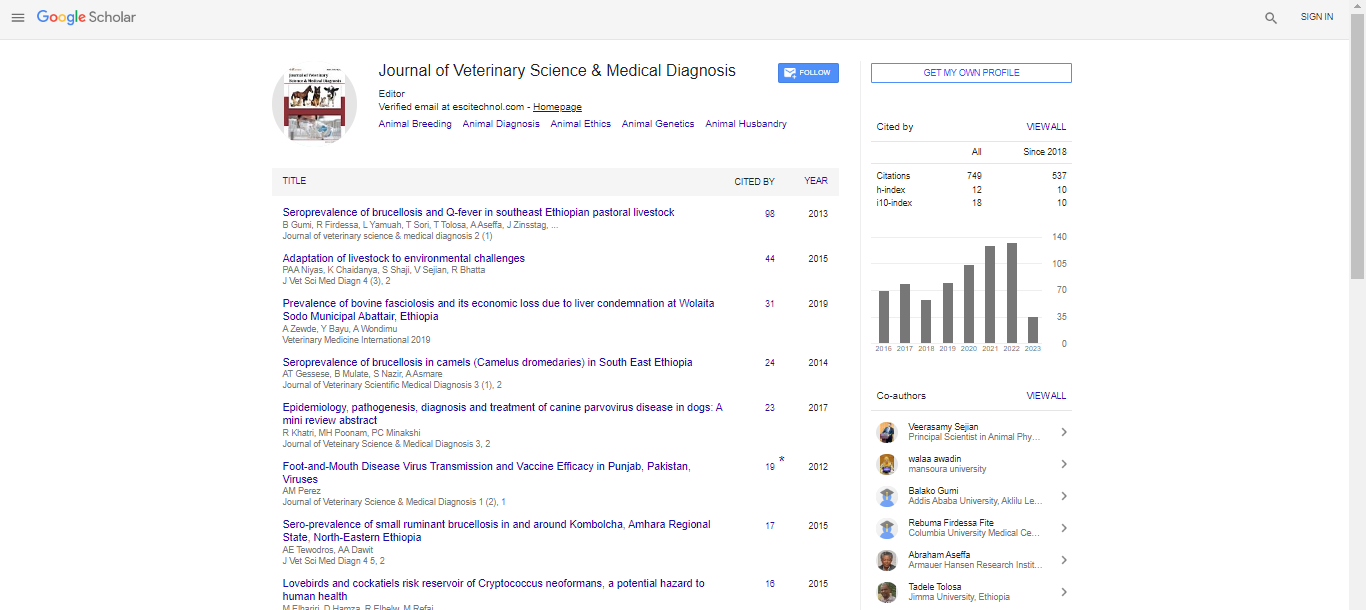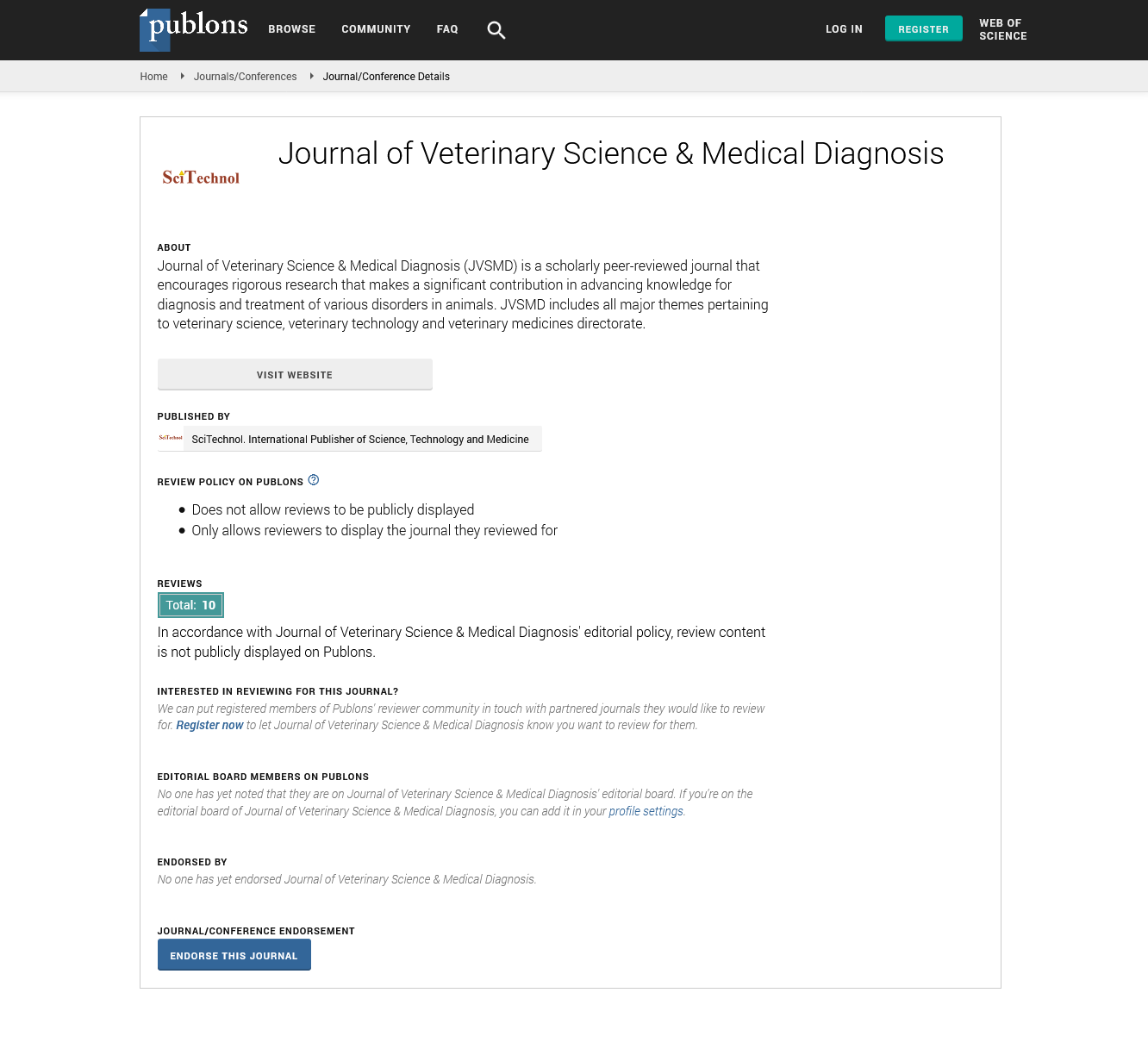Opinion Article, J Vet Sci Med Diagn Vol: 12 Issue: 4
Role of Animal Vaccination in Preventing Zoonotic Outbreaks
Sherrie Jean*
1Department Veterinary of Pathology, Emory University School of Medicine, Aetlanta, Georgia
*Corresponding Author: Sherrie Jean,
Department Veterinary of Pathology,
Emory University School of Medicine, Aetlanta, Georgia
E-mail: sherrie@zoo.edu
Received date: 26 Jun, 2023, Manuscript No. JVSMD-23-111864;
Editor assigned date: 30 Jun, 2023, Pre QC No. JVSMD-23-111864 (PQ);
Reviewed date: 14 Jul, 2023, QC No. JVSMD-23-111864;
Revised date: 21 Jul, 2023, Manuscript No: JVSMD-23-111864 (R);
Published date: 28 Jul, 2023, DOI: 10.35248/2325-9590.23.12.1000062
Citation: Jean S (2023) Role of Animal Vaccination in Preventing Zoonotic Outbreaks. J Vet Sci Med Diagn 12:4.
Description
Zoonotic diseases can be transmitted from animals to humans, have a profound impact on public health, economies, and global stability. The rise of zoonotic diseases such as COVID-19, Ebola, and avian influenza has the need to understanding and managing these threats. Animal vaccination stands as an important tool in preventing zoonotic outbreaks, as it not only safeguards the health and welfare of animals but also serves as a barrier against the transmission of diseases from animals to humans. Zoonotic diseases have been a part of human history for centuries. They emerge from a complex interplay of factors, including changes in human behavior, encroachment into wildlife habitats, intensive animal agriculture, and global trade and travel. These diseases can originate in wildlife populations, domestic animals, or a combination of both. The transmission of zoonotic pathogens from animals to humans can lead to outbreaks that vary in scale and severity.
Animal vaccination is an important strategy to break the cycle of zoonotic transmission at its source. Vaccinating animals against diseases known to be zoonotic or those with the potential to become zoonotic is imperative for preventing these diseases. Healthy animals are less likely to transmit pathogens to humans. Wild and domestic animals can serve as reservoirs for zoonotic pathogens. Vaccination reduces the prevalence of these pathogens in animal populations, lowering the risk of transmission to humans. Vaccinated animals are less likely to become infected with zoonotic pathogens and subsequently transmit these pathogens to humans. This minimizes the chances of transmission. Preventing disease outbreaks in wildlife through vaccination contributes to ecosystem stability and conservation efforts.
Rabies is a prime example of a zoonotic disease that can be controlled through animal vaccination. Vaccinating domestic dogs, a common vector of rabies transmission, reduces human exposure and prevents outbreaks. The poultry industry has witnessed several outbreaks of avian influenza with zoonotic potential. Vaccination of poultry flocks helps prevent the spread of avian influenza viruses to humans and curbs, the economic losses associated with culling infected birds. Brucellosis- bacterial disease is transmissible from animals to humans through contact with infected animals or their products. Vaccination of livestock helps to decrease the prevalence of Brucella in animal populations and reduces the risk to humans.
While animal vaccination is a powerful tool in preventing zoonotic outbreaks, several challenges need to be addressed: Ensuring high vaccine coverage and compliance among animal populations, particularly in resource-limited areas, can be challenging. Regular monitoring of vaccine efficacy, disease prevalence, and pathogen mutations is essential to adapt vaccination strategies as needed. Some zoonotic pathogens exhibit genetic diversity that complicates the development of effective vaccines. Achieving cross-species protection may require innovative approaches. Zoonotic disease prevention requires a multidisciplinary approach that involves collaboration between human and animal health sectors, environmental agencies, and policymakers.
As we continue to face novel zoonotic threats and recognize the interconnectedness of human, animal, and environmental health, investing in robust animal vaccination programs becomes not only a public health imperative but also a testament to our responsibility for both the animal kingdom and the human race. Through strategic vaccination efforts and a comprehensive One Health approach, humans can mitigate the risks of future zoonotic outbreaks and safeguard the well-being of both animals and humans.
 Spanish
Spanish  Chinese
Chinese  Russian
Russian  German
German  French
French  Japanese
Japanese  Portuguese
Portuguese  Hindi
Hindi 
